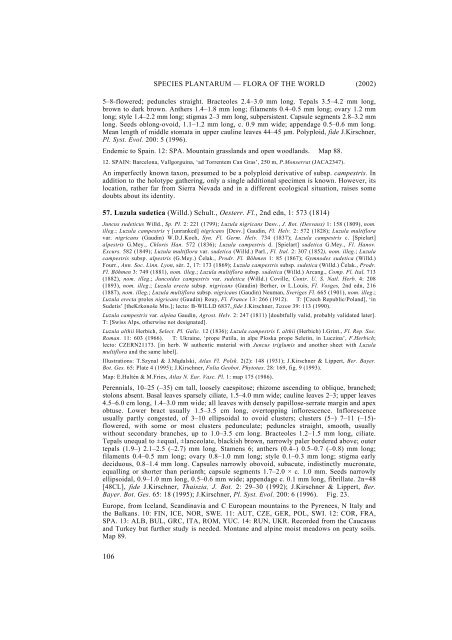Part 6. JUNCACEAE 1: Rostkovia to Luzula - Species Plantarum ...
Part 6. JUNCACEAE 1: Rostkovia to Luzula - Species Plantarum ...
Part 6. JUNCACEAE 1: Rostkovia to Luzula - Species Plantarum ...
You also want an ePaper? Increase the reach of your titles
YUMPU automatically turns print PDFs into web optimized ePapers that Google loves.
106<br />
SPECIES PLANTARUM — FLORA OF THE WORLD (2002)<br />
5–8-flowered; peduncles straight. Bracteoles 2.4–3.0 mm long. Tepals 3.5–4.2 mm long,<br />
brown <strong>to</strong> dark brown. Anthers 1.4–1.8 mm long; filaments 0.4–0.5 mm long; ovary 1.2 mm<br />
long; style 1.4–2.2 mm long; stigmas 2–3 mm long, subpersistent. Capsule segments 2.8–3.2 mm<br />
long. Seeds oblong-ovoid, 1.1–1.2 mm long, c. 0.9 mm wide; appendage 0.5–0.6 mm long.<br />
Mean length of middle s<strong>to</strong>mata in upper cauline leaves 44–45 µm. Polyploid, fide J.Kirschner,<br />
Pl. Syst. Evol. 200: 5 (1996).<br />
Endemic <strong>to</strong> Spain. 12: SPA. Mountain grasslands and open woodlands. Map 88.<br />
12. SPAIN: Barcelona, Vallgorguina, ‘ad Torrentem Can Gras’, 250 m, P.Monserrat (JACA2347).<br />
An imperfectly known taxon, presumed <strong>to</strong> be a polyploid derivative of subsp. campestris. In<br />
addition <strong>to</strong> the holotype gathering, only a single additional specimen is known. However, its<br />
location, rather far from Sierra Nevada and in a different ecological situation, raises some<br />
doubts about its identity.<br />
57. <strong>Luzula</strong> sudetica (Willd.) Schult., Oesterr. Fl., 2nd edn, 1: 573 (1814)<br />
Juncus sudeticus Willd., Sp. Pl. 2: 221 (1799); <strong>Luzula</strong> nigricans Desv., J. Bot. (Desvaux) 1: 158 (1809), nom.<br />
illeg.; <strong>Luzula</strong> campestris γ [unranked] nigricans [Desv.] Gaudin, Fl. Helv. 2: 572 (1828); <strong>Luzula</strong> multiflora<br />
var. nigricans (Gaudin) W.D.J.Koch, Syn. Fl. Germ. Helv. 734 (1837); <strong>Luzula</strong> campestris c. [Spielart]<br />
alpestris G.Mey., Chloris Han. 572 (1836); <strong>Luzula</strong> campestris d. [Spielart] sudetica G.Mey., Fl. Hanov.<br />
Excurs. 582 (1849); <strong>Luzula</strong> multiflora var. sudetica (Willd.) Parl., Fl. Ital. 2: 307 (1852), nom. illeg.; <strong>Luzula</strong><br />
campestris subsp. alpestris (G.Mey.) Čelak., Prodr. Fl. Böhmen 1: 85 (1867); Gymnodes sudetica (Willd.)<br />
Fourr., Ann. Soc. Linn. Lyon, sér. 2, 17: 173 (1869); <strong>Luzula</strong> campestris subsp. sudetica (Willd.) Čelak., Prodr.<br />
Fl. Böhmen 3: 749 (1881), nom. illeg.; <strong>Luzula</strong> multiflora subsp. sudetica (Willd.) Arcang., Comp. Fl. Ital. 713<br />
(1882), nom. illeg.; Juncoides campestris var. sudetica (Willd.) Coville, Contr. U. S. Natl. Herb. 4: 208<br />
(1893), nom. illeg.; <strong>Luzula</strong> erecta subsp. nigricans (Gaudin) Berher, in L.Louis, Fl. Vosges, 2nd edn, 216<br />
(1887), nom. illeg.; <strong>Luzula</strong> multiflora subsp. nigricans (Gaudin) Neuman, Sveriges Fl. 665 (1901), nom. illeg.;<br />
<strong>Luzula</strong> erecta proles nigricans (Gaudin) Rouy, Fl. France 13: 266 (1912). T: [Czech Republic/Poland], ‘in<br />
Sudetis’ [theKrkonoše Mts.]; lec<strong>to</strong>: B-WILLD 6837, fide J.Kirschner, Taxon 39: 113 (1990).<br />
<strong>Luzula</strong> campestris var. alpina Gaudin, Agrost. Helv. 2: 247 (1811) [doubtfully valid, probably validated later].<br />
T: [Swiss Alps, otherwise not designated].<br />
<strong>Luzula</strong> althii Herbich, Select. Pl. Galic. 12 (1836); <strong>Luzula</strong> campestris f. althii (Herbich) I.Grint., Fl. Rep. Soc.<br />
Roman. 11: 603 (1966). T: Ukraine, ‘prope Putila, in alpe Ploska prope Seletin, in Luczina’, F.Herbich;<br />
lec<strong>to</strong>: CZERN21173. [in herb. W authentic material with Juncus triglumis and another sheet with <strong>Luzula</strong><br />
multiflora and the same label].<br />
Illustrations: T.Szynal & J.Mądalski, Atlas Fl. Polsk. 2(2): 148 (1931); J.Kirschner & Lippert, Ber. Bayer.<br />
Bot. Ges. 65: Plate 4 (1995); J.Kirschner, Folia Geobot. Phy<strong>to</strong>tax. 28: 169, fig. 9 (1993).<br />
Map: E.Hultén & M.Fries, Atlas N. Eur. Vasc. Pl. 1: map 175 (1986).<br />
Perennials, 10–25 (–35) cm tall, loosely caespi<strong>to</strong>se; rhizome ascending <strong>to</strong> oblique, branched;<br />
s<strong>to</strong>lons absent. Basal leaves sparsely ciliate, 1.5–4.0 mm wide; cauline leaves 2–3; upper leaves<br />
4.5–<strong>6.</strong>0 cm long, 1.4–3.0 mm wide; all leaves with densely papillose-serrate margin and apex<br />
obtuse. Lower bract usually 1.5–3.5 cm long, over<strong>to</strong>pping inflorescence. Inflorescence<br />
usually partly congested, of 3–10 ellipsoidal <strong>to</strong> ovoid clusters; clusters (5–) 7–11 (–15)flowered,<br />
with some or most clusters pedunculate; peduncles straight, smooth, usually<br />
without secondary branches, up <strong>to</strong> 1.0–3.5 cm long. Bracteoles 1.2–1.5 mm long, ciliate.<br />
Tepals unequal <strong>to</strong> ±equal, ±lanceolate, blackish brown, narrowly paler bordered above; outer<br />
tepals (1.9–) 2.1–2.5 (–2.7) mm long. Stamens 6; anthers (0.4–) 0.5–0.7 (–0.8) mm long;<br />
filaments 0.4–0.5 mm long; ovary 0.8–1.0 mm long; style 0.1–0.3 mm long; stigma early<br />
deciduous, 0.8–1.4 mm long. Capsules narrowly obovoid, subacute, indistinctly mucronate,<br />
equalling or shorter than perianth; capsule segments 1.7–2.0 × c. 1.0 mm. Seeds narrowly<br />
ellipsoidal, 0.9–1.0 mm long, 0.5–0.6 mm wide; appendage c. 0.1 mm long, fibrillate. 2n=48<br />
[48CL], fide J.Kirschner, Thaiszia, J. Bot. 2: 29–30 (1992); J.Kirschner & Lippert, Ber.<br />
Bayer. Bot. Ges. 65: 18 (1995); J.Kirschner, Pl. Syst. Evol. 200: 6 (1996). Fig. 23.<br />
Europe, from Iceland, Scandinavia and C European mountains <strong>to</strong> the Pyrenees, N Italy and<br />
the Balkans. 10: FIN, ICE, NOR, SWE. 11: AUT, CZE, GER, POL, SWI. 12: COR, FRA,<br />
SPA. 13: ALB, BUL, GRC, ITA, ROM, YUC. 14: RUN, UKR. Recorded from the Caucasus<br />
and Turkey but further study is needed. Montane and alpine moist meadows on peaty soils.<br />
Map 89.












